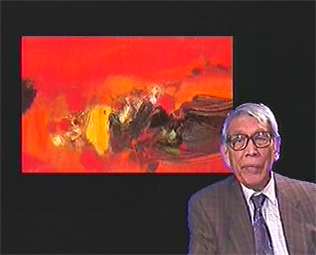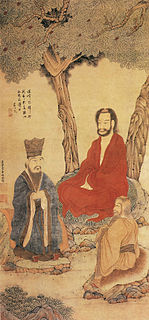 W
WChu Teh-Chun or Zhu Dequn was a Chinese-French abstract painter acclaimed for his pioneering style integrating traditional Chinese painting techniques with Western abstract art. Chu Teh-Chun enrolled in the National School of Fine Arts, where he studied under Fang Ganmin and Wu Dayu. He was the first ethnic Chinese member of the Académie des Beaux-Arts of France, and together with Wu Guanzhong and Zao Wou-Ki were dubbed the "Three Musketeers" of modernist Chinese artists trained in China and France.
 W
WCui Bai was a prominent Chinese painter of the Northern Song Dynasty (960–1279). A native of Anhui Province, Cui was best known for paintings of animals and plants. At some point during his life, he traveled to the capital of Kaifeng to seek employment as a court artist, and was accepted by Emperor Shenzong of Song, who admired his works. He became a renowned artist of Shenzong's court, but gained an awkward reputation for his often eccentric behavior.
 W
WDing Yunpeng was a Chinese painter especially of human figures and landscapes during the Ming Dynasty (1368–1644).
 W
WHu Zhengyan was a Chinese artist, printmaker and publisher. He worked in calligraphy, traditional Chinese painting, and seal-carving, but was primarily a publisher, producing academic texts as well as records of his own work.
 W
WJiang Linhe is a Chinese painter, famous for depictions of nature.
 W
WLi Gonglin, style name Boshi (伯時), art name Longmian Jushi, was a Chinese antiquarian, painter, and politician during the Northern Song Dynasty.
 W
WLiu Kuo-sung is a Taiwanese artist based in Shanghai, China, and Taoyuan, Taiwan. Liu is widely regarded as one of the earliest and most important advocates and practitioners of modernist Chinese painting. He is also a writer on contemporary Chinese art.
 W
WBorn in 1915 in Fengyang County, Anhui Province, China, Liu Zhibai is one of the most innovative masters in modern Chinese ink painting. Liu Zhibai studied in Suzhou in 1933, in China's best Art school at the time: the Suzhou Fine Arts College.
 W
WMei Qing was a Chinese landscape painter, calligrapher and poet active during the Qing Dynasty.
 W
WSun Duoci was a Chinese artist. Famous for her oil paintings, sketches and ink and wash works, she was an accomplished artist, as well as a calligrapher and writer. One of her pieces has sold at auction for more than $100,000. She was taught by the well-known artist Xu Beihong, who regarded her as a "painter of genius" and had an affair with him.
 W
WWang Xibang was a contemporary Chinese painter, calligrapher, poet, educator, and antique collector. Wang Xibang excelled in calligraphy and painting of plum blossom, pine, lotus, peony, wisteria, and loquat tree. He was the founder of Xin’an Association of Fine Arts, a member of the Chinese Artists Association, and a member of the Chinese Poet Association.
 W
WXū Gǔ ; ca. (1824–1896) was a Chinese painter and poet during the Qing Dynasty (1644–1912).
 W
WZha Shibiao or Cha Shih-piao was a Chinese calligrapher and landscape painter from Anhui. He was affiliated with the Anhui School, also known as the Xin'an School, which is noted for dry brushstrokes and sparse compositions. His family, and himself, were art collectors and Ming dynasty aristocrats. He had studied for the civil service exam under the Ming and received the xiucai degree in his twenties. However he abandoned any attempt at an official career after the Manchu conquest. Subsequent to the 1670s he moved, or fled, depending on the source, to Yangzhou. As a calligrapher he was influenced by Dong Qichang and Mi Fu. His landscapes were more influenced by Hong Ren and Ni Zan. His later works are considered to have had a more moist and expressive feel than those of Hong Ren. As a person he was said to be easy-going, but slightly reclusive. He also had a fondness for drink, indulging into the late hours.